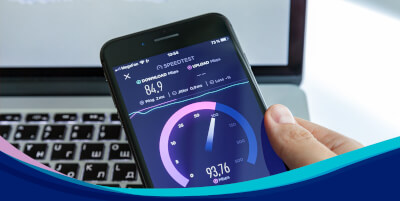Is full fibre broadband worth the price tag?
 Dan Howdle • March 5th, 2024
Dan Howdle • March 5th, 2024

It seems only a few short years ago broadband companies were pushing customers from 10-11Mbps ADSL lines to this new-fangled 'up to 75Mbps' 'fibre' technology. And then, just as it is now with full fibre (the latest iteration of the tech), we all had to be concerned first and foremost with whether we can get it. The rollout of new fibre technology can feel slow, and at this point in 2024, only around a third of us can get full fibre. But if you can get it, should you?
What is full fibre broadband?
The easiest way to explain what full fibre is and how it differs from other broadband technologies is simply to show it in comparison to the broadband types that preceded it:
| Type of fibre | Also known as | Advertised speeds | Actual speed you'll get |
|---|---|---|---|
| Superfast fibre | FTTC | 36, 61Mbps (or thereabouts) | 20-75Mbps |
| Full fibre | FTTP | 100, 150, 500, 900Mbps, 1.6Gbps | As advertised |
| Cable fibre | Virgin Media | 54, 132, 264, 362, 516, 1130Mbps | As advertised |
Notice from this table there are essentially four different types of broadband available to this day, and sometimes you'll find all four available in the same street, while other locations may be limited to just two types (ADSL and Superfast fibre), or if you're very unlucky, just one (ADSL).
In fact, the only way to get an ADSL broadband deal here in 2024 is if you can't get anything better. Most broadband providers no longer advertise ADSL deals on their websites, and they can only be found through a postcode situation that reveals that's all there is.
Virgin Media is it's own thing. Its network covers around 60% of UK homes, and it delivers its broadband via a unique network, using unique cabling technology that can be described neither as full fibre nor, technically, Superfast Fibre. That said, its technology does allow for some exceptionally fast speeds very much in competition with full fibre.
Full fibre on Openreach
Openreach is the network that's used by all of the UK's major broadband providers – so, Sky, BT, TalkTalk, Plusnet and so on – and most full fibre deal you will find will use this network. There are some exceptions in the form of so-called 'altnets' (alternative networks). These are small, local providers that operate on their own full fibre networks. They are usually very good, and can often provide speeds and equipment beyond what you'd typically find in a full fibre deal from a provider using Openreach.
For the rest of this article though, when we talke about getting full fibre, we're really going to be talking mainly about getting it via Openreach.
What are the benefits of full fibre?
Full fibre, if you can get it, has several advantages over the previous 'Superfast Fibre' technology. full fibre is:
- Much, much faster: Providers like EE Broadband are already advertising frankly unnecessarily fast packages of up to 1.6Gbps (1,600Mbps in old money). That's around 26 times faster than the average speed of the fastest Superfast Fibre packages. On paper there is nothing stopping full fibre from reaching speeds of 10Gbps (10,000Mbps) or more, but that's on paper. The reality is you would need bleeding-edge, excruciatingly expensive home networking tech to make use of such speeds
- More reliable: Unlike Superfast Fibre, which uses a mixture of copper and fibre optic cables, full fibre is all one thing: Fibre optic. The simplicity means greater reliability, and full fibre connections are less likely to experience issues
- More likely to get you a good router: Broadband providers have a tendency to provide their best router with full fibre deals because this makes it easier for you to upgrade your speed later on to a speed that really needs the new router's features
Is full fibre available in my area?
This is the crux of the matter when it comes to full fibre, because if you can't get it, and conversation about whether it's any good or not becomes moot. The best way to determine if you can get full fibre where you live is to use our postcode checker. Doing so will tell you everything you can get at your address. We don't store any information, and will only use your postcode to show you what you can get.
What if I can't get full fibre?
You may find you can't get full fibre. In fact, about two thirds of us can't. If your reasoning for wanting full fibre is simply a desire for much faster download speeds however, you may have more luck with Virgin Media. Virgin Media is available to nearly two thirds of UK homes, so nearly double your chances of getting it!
-
 £80 gift cardFull Fibre 500
£80 gift cardFull Fibre 500- 500Mb average speed +
- Unlimited usage +
- PAYG calls
- £80 Gift Card
£33.00 per month(prices may change during contract)£80 gift card£5 one-off cost24 month contract -
 M500 Fibre Broadband
M500 Fibre Broadband- 516Mb average speed +
- Unlimited usage +
- No phone line
£33.99 per month(prices may change during contract)£0 one-off cost18 month contract -
 Gig1 Fibre Broadband
Gig1 Fibre Broadband- 1.1Gb average speed +
- Unlimited usage +
- No phone line
£40.99 per month(prices may change during contract)£0 one-off cost18 month contract
Is full fibre broadband expensive?
When a new technology is introduced, typically the companies providing it will try to take advantage of early adopters – people who must have the very latest thing. But the case of full fibre is a bit different. Provider actively want those who can switch to full fibre to do so, and the reasons for this are manifold, but mainly have to do with the economic considerations of running a network and service with multiple different technologies and multiple different equipment supplied to the customer. And because providers want you to switch to full fibre if you can, the prices are little more, or in many cases not at all, more expensive.
Of course, that doesn't mean that much faster packages don't cost more. No, what we're saying is that, for example, a 100Mbps full fibre package is currently priced similarly to a 61Mbps Superfast Fibre package, but that prices go up the faster you go from there.
I can get full fibre, but what speed should I get?
First off, let's not get too carried away when it comes to full fibre. The top-speed packages are far quicker than most households currently need. Even households full of gamers don't really need 900Mbps, though it does, admittedly, shorten the time spent waiting for those big games to download. The situation can broadly be described as more speed being available than most of us need.
We can visualise this easily by looking at the sort of speed we need for the things we all do online most of the time, and evaluating that against the fastest full fibre speed currently available (1.6Gbps):
| Activity | Speed required | On 1.6Gbps full fibre |
|---|---|---|
| Browsing the internet | 2-10mbps | 160 people could be happily browsing the internet at the same time |
| Watching Netflix or Disney+ in 4K | 15-20Mbps | 80 people could be watching a movie in 4K, on 80 TVs at the same time |
| Playing a competitive online game | 500Kbps-2Mbps | 800 people could be playing Call Of Duty at the same time |
| Downloading large videogames | As fast as possible* | The faster the speed, the quicker you can download, but there are big caveats |
As you can see, those top speeds are more than a little absurd. And they create problems with home networking we won't go into in detail here, but suffice to say your devices aren't ready for 1.6Gbps broadband, and at best you'll be able to make use of around 900Mbps of that to a single device. But why would you? It's expensive and you'll seldom ever use that much bandwidth.
Our current recommendation is that 150Mbps is plenty for most households when it comes to full fibre, while 500Mbps packages may be worth a look if several members of your household do a lot of downloading of large files such as videogames. 900Mbps of 1.6Gbps are really only useful for one-upmanship with the Joneses and don't have a lot of utility in the real world just yet.
Conclusion: So, should I get full fibre broadband or not?
If you can get it, yes. It's faster, more reliable, more future-proof and makes it a lot easier to upgrade if you suddenly require more speed. Providers also want you to opt for full fibre. They would prefer it, and to that end are tending to focus their new-customer sweetener deals around full fibre more so than just acquiring new customers onto Superfast Broadband.
